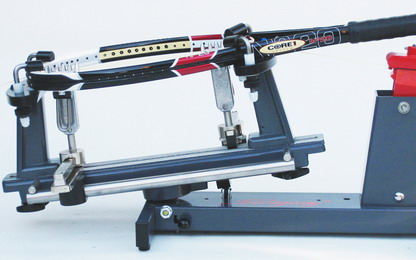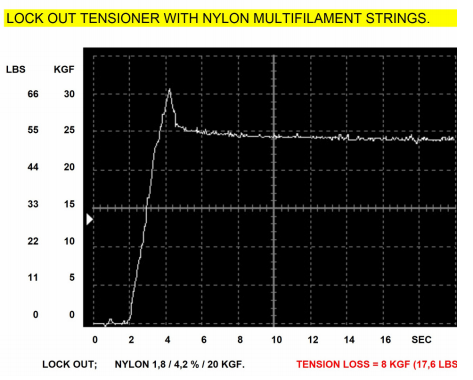Hi, I'm from beijing, china. Doing some research about stringing machine.
Recently I found there has a confused concept in how to choose the stringin machine. Someone thought that dropweight is more accurate than crank because of the Constant Pull. But after reading some paper about the constant pull and dropweight, such as "The_Importance_Of_Constant_Pull.pdf"(google), i think it's a wrong concept about the dropweight with constant pull.
I read the "The physics of a dropweight tensioner ", It's great. Explained the princple of the dropweight lever.
http://tt.tennis-warehouse.com/showthread.php?t=170414
But I think it lost a variable about "string elongated", many people using Pre-Stretch is to solve this problem.
CP(ConstantPull) is to solve this problem too.
I just thought here has a mis-info about the DP(dropweight) with CP(ConstantPull).
In my opinion, the CP is 1. Constant Tension, 2. Continuously Pull(for a time scale).
CP is a time sensitive method, not easy to control. Here just talk about the princple of the CP and DP machine.
Pre-Stretch is better. Using Pre-stretch is good choice for most stringer, it is easy to control and more accurately.
As shown in the pic,
Left is constant tension, continuously pull whether the string is elongated or not for a time. Because the weight is same, the R is same.
Right has a lever, if the string is elongated for a time, the lever will not be hoding the H position. The string tension will not be same as before. f = (M g / r) (cos Q) R(from lethalfang). If the tension lost too much, for example Q=-90, the string tension is 0.
So if add the "string elongated" variable, the DP is not a accurate system. It need people to adjust the tension.
Some one said crank is not accurate because it is locked at the tension. But it is same as DP, it is losing tension after locked.
kwun(badmintoncentral) made a caculate about the DP error. About 1.5%
"force = weight * cos(alpha)
the alpha is the same alpha that you listed in your diagram.
but if you look at how the value of cosine changes, you will realize that even when alpha = 10 degrees (which is quite a lot), cos(10 deg) is only 0.9848, which amount to a error of 1.5%. that is hardly of any concern at all."
I also do that for crank system.
"As you said, if the string is elongated to 10deg, the r of the gripper is about 3cm.
10/360*2*3.14*3=0.523cm, it means the string be elongated about 0.523cm
For the dropweight machine, length of one string from the racket head to the gripper is about 40cm, if using a crank machine to pull the 40cm string, string elongated same, it is 0.523/40, the error is about 0.13%.
"
So the error for DP and crank is almost same.
But for the crank machine, the string length from the racket head to the gripper is much less than 40 cm, it is much shorter than the dropweight, shorter string length mean tension lose less.
After some research about electronic machine, I think the electronic is almost same as crank. Crank using hand and brand, electronic using moto and programmed chip.
Then I got this machine choice instruction, Accurate, Performance, Price:
Electronic >> Crank >> DropWeight >> Awls/Puller

I also read the Stringway DropWeight Constant Pull machine. I think call it DropWeight+Constant Pull machine is better. Its point is "Lifts automatically at the position of the tenionhead."
If I'm right, its princple is to put the string elongated at the left, then the lever at the right will hold the H position, the tension will be same even the string elongated. So it has a particular function to fix the dropweight problem. Most other dropweight machine didn't has that function, so they are DP machine, but no CP function.
It's long... time didn't write english, hope it can explain clearly
http://www.stringway-nl.com/USA/

Recently I found there has a confused concept in how to choose the stringin machine. Someone thought that dropweight is more accurate than crank because of the Constant Pull. But after reading some paper about the constant pull and dropweight, such as "The_Importance_Of_Constant_Pull.pdf"(google), i think it's a wrong concept about the dropweight with constant pull.
I read the "The physics of a dropweight tensioner ", It's great. Explained the princple of the dropweight lever.
http://tt.tennis-warehouse.com/showthread.php?t=170414
But I think it lost a variable about "string elongated", many people using Pre-Stretch is to solve this problem.
CP(ConstantPull) is to solve this problem too.
I just thought here has a mis-info about the DP(dropweight) with CP(ConstantPull).
In my opinion, the CP is 1. Constant Tension, 2. Continuously Pull(for a time scale).
CP is a time sensitive method, not easy to control. Here just talk about the princple of the CP and DP machine.
Pre-Stretch is better. Using Pre-stretch is good choice for most stringer, it is easy to control and more accurately.
As shown in the pic,
Left is constant tension, continuously pull whether the string is elongated or not for a time. Because the weight is same, the R is same.
Right has a lever, if the string is elongated for a time, the lever will not be hoding the H position. The string tension will not be same as before. f = (M g / r) (cos Q) R(from lethalfang). If the tension lost too much, for example Q=-90, the string tension is 0.
So if add the "string elongated" variable, the DP is not a accurate system. It need people to adjust the tension.
Some one said crank is not accurate because it is locked at the tension. But it is same as DP, it is losing tension after locked.
kwun(badmintoncentral) made a caculate about the DP error. About 1.5%
"force = weight * cos(alpha)
the alpha is the same alpha that you listed in your diagram.
but if you look at how the value of cosine changes, you will realize that even when alpha = 10 degrees (which is quite a lot), cos(10 deg) is only 0.9848, which amount to a error of 1.5%. that is hardly of any concern at all."
I also do that for crank system.
"As you said, if the string is elongated to 10deg, the r of the gripper is about 3cm.
10/360*2*3.14*3=0.523cm, it means the string be elongated about 0.523cm
For the dropweight machine, length of one string from the racket head to the gripper is about 40cm, if using a crank machine to pull the 40cm string, string elongated same, it is 0.523/40, the error is about 0.13%.
"
So the error for DP and crank is almost same.
But for the crank machine, the string length from the racket head to the gripper is much less than 40 cm, it is much shorter than the dropweight, shorter string length mean tension lose less.
After some research about electronic machine, I think the electronic is almost same as crank. Crank using hand and brand, electronic using moto and programmed chip.
Then I got this machine choice instruction, Accurate, Performance, Price:
Electronic >> Crank >> DropWeight >> Awls/Puller
I also read the Stringway DropWeight Constant Pull machine. I think call it DropWeight+Constant Pull machine is better. Its point is "Lifts automatically at the position of the tenionhead."
If I'm right, its princple is to put the string elongated at the left, then the lever at the right will hold the H position, the tension will be same even the string elongated. So it has a particular function to fix the dropweight problem. Most other dropweight machine didn't has that function, so they are DP machine, but no CP function.
It's long... time didn't write english, hope it can explain clearly
http://www.stringway-nl.com/USA/









